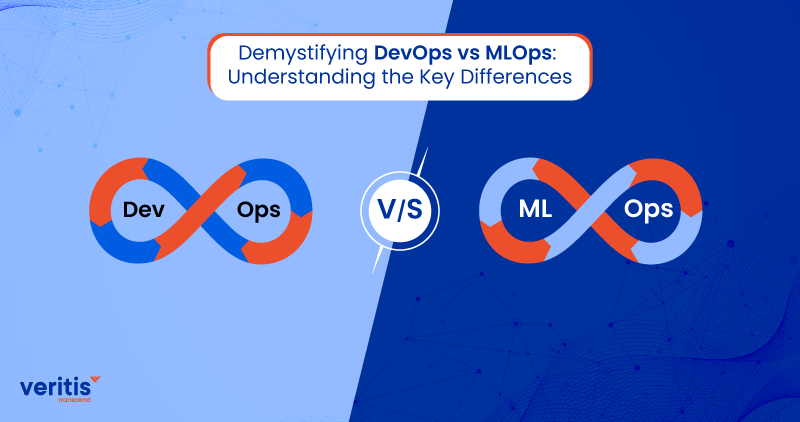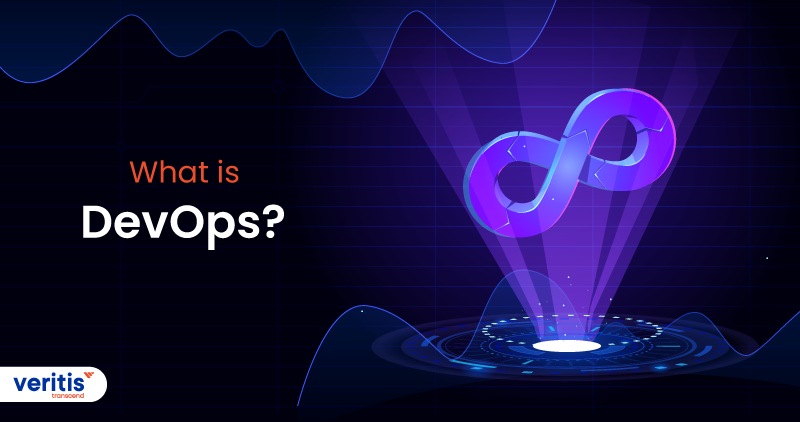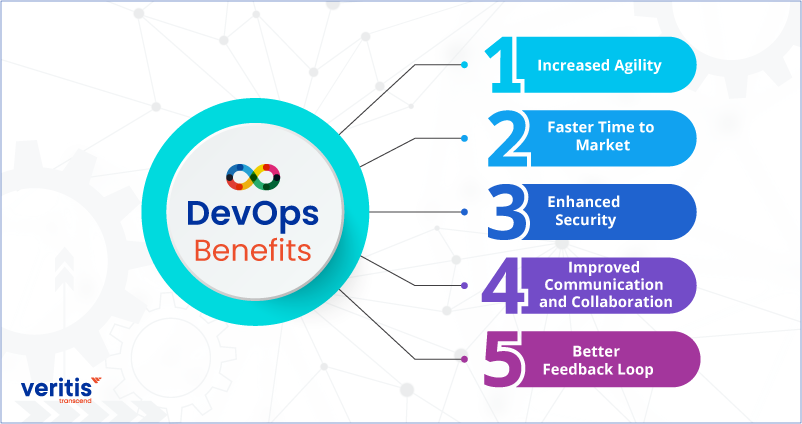
The term DevOps has been used to describe how software developers and IT operations work together. A new concept called MLOps, combining DevOps and machine learning (ML), is gaining attention for various reasons.
DevOps and MLOps are software development strategies involving developers, operations, and data science collaboration. The primary difference is that DevOps focuses on application development, while MLOps is about machine learning.
In DevOps, we integrate programming, testing, and deployment for web apps and software. MLOps aims to do something similar by streamlining the machine learning DevOps model process. It stitches together this lifecycle to create a smooth and efficient process with fewer obstacles. We’ll explore the differences between DevOps Vs MLOps step by step.
What is DevOps?

In a software company, there are two teams: development and operations. The development team creates new systems, while the operations team tests and implements the products. Sometimes, the operations team provides feedback on bugs, causing delays in the development cycle.
DevOps is about breaking barriers between development and operations teams through collaboration. It’s a popular IT concept that involves software development, operation, and management across a system. DevOps is not just a single tool or method; it’s an approach that enables greater agility in operations. It emphasizes collaboration between developers and manual and automated systems.
How Does DevOps Work?
DevOps unites Development and Operations teams, breaking down traditional silos between them. These teams operated separately in the past and had to invest much time and effort in meetings and emails to stay informed.
Adopting DevOps shifts the focus from departmental goals to organizational goals, fostering collaboration and proactivity. With automated tools and faster processes, teams work closely, identifying and resolving issues swiftly. DevOps prioritizes security and automates and monitors the complete software delivery process, from development to production.
DevOps serves multiple purposes:
- Faster launch of new features
- Increased customer and developer satisfaction through efficient processes
- Feedback loops for better communication
Key DevOps principles include:
- Automation
- Self-service
- Collaboration
- Iteration
- Continuous improvement
- Continuous testing
Useful link: Future of DevOps: Top DevOps Trends in 2023 and Beyond
DevOps Lifecycle
The DevOps lifecycle consists of four main stages represented as an infinity loop. These stages create a feedback loop, allowing organizations to rapidly deliver quality-tested solutions to customers.
1) Design and Plan
The initial stage of the DevOps lifecycle is planning. In this phase, stakeholders from the business, development, and IT teams collaborate to determine the features to include in the upcoming development cycle and assess their value for the business.
2) Continuous Integration
Next is continuous integration, a DevOps approach consisting of three steps: code, build, and test. These steps aim to improve product quality and utilize automation for building it. In this model, code changes are frequently merged into the central repository. An automated tool fetches the code base and tests its quality. After testing, a binary solution is built and functionally tested.
Teams can use manual and automated testing to generate comprehensive reports that benefit the organization.
3) Continuous Deployment
Continuous deployment is another part of the DevOps model that combines the Release and Deploy stages. Any quality-tested build will be automatically released and deployed to pre-production or production environments. The DevOps team can adjust the release and deployment frequency as needed.
4) Continuous Monitoring
Continuous monitoring is the final stage of the DevOps lifecycle, consisting of two parts: Operate and Monitor. It involves overseeing software operations, gathering crucial security and health information, and collaborating with team members to resolve issues swiftly and effectively.
DevOps Benefits

DevOps can make organizations more flexible, enhance teamwork and communication, and speed up the time it takes to launch products or services.
1) Increased Agility
In DevOps, a crucial practice is automating the software development and delivery process. This means using machines to do repetitive tasks like testing code, deploying software, and setting up infrastructure, which people usually do. By doing this, DevOps allows us to handle changes quickly and efficiently.
2) Faster Time to Market
DevOps helps get new code changes, like bug fixes or new features, into production faster. It automates tasks like code testing and deployment and focuses on secure solutions. This makes the development and operations teams quicker and more flexible, provides readily available solutions, and makes businesses more competitive.
3) Enhanced Security
DevOps solutions often include security measures to improve efficiency and results. They call it DevSecOps. This means integrating security into the products and features throughout the development process, not just at the end. By doing this, teams can find and fix security problems early instead of waiting until the end. DevSecOps delivers solutions faster and reduces the cost of making software.
4) Improved Communication and Collaboration
DevOps implementation works by having the Dev and Ops teams communicate and collaborate closely. When they understand each other’s requirements and priorities, they can solve problems quickly and more efficiently.
5) Better Feedback Loop
A feedback loop is like gathering information from different parts of the organization and sharing it with the right teams. These teams can then use the information to improve and deliver the solution faster.
DevOps uses automation and “right-to-left” feedback to make the feedback loop easier. This means that information from later stages of development is sent back to earlier stages automatically. For example, if there’s an error during the build phase, the testing team gets notified immediately to fix it. This way, the DevOps best practices feedback loop makes the process faster and improves the quality of products.
Useful link: Why Should You Adopt DevOps and What are the Benefits it Offers?
DevOps Model Challenges

Using the DevOps solutions model makes development and releasing things more efficient, but it also comes with challenges.
1) Culture Shift
DevOps needs a cultural shift. It means the Dev and Ops teams must work together, understand shared responsibilities, and collaborate to solve problems. If the teams can’t solve this challenge from the beginning, it will affect the efficiency of the whole development unit and the organization. One way to overcome this is by creating a shared vision through team communication.
2) Adoption of Tools
DevOps uses new tools, so older systems must be replaced with newer ones. This might seem challenging, but training team members to use these modern tools is essential to overcome this obstacle.
It’s not just about using fancy new tools when transitioning to the DevOps best practices culture. Many new tools appear in the market frequently. Instead, focus on getting the tools that suit your business needs best.
3) Establishing Metrics and Processes
Using the DevOps model involves changing how things are done. It can include setting up a CI/CD pipeline or creating automated tests. When following these new processes, you must also choose and track the right DevOps implementation metrics. To do this, you must carefully examine the processes and pick metrics that align with your business goals.
Doing all of these things at once can be a big job. To handle this challenge, you can start small. To tackle it effectively, begin with a small pilot program and a testing framework.
4) Change Management
DevOps needs a culture of always getting better and learning continuously. Organizations should know that processes and tools may change as they move further into DevOps implementation or the product grows. The organization and the DevOps team should be flexible and adapt to the changing needs. To adapt, you need accountability, always trying to get better, and never stop learning.
Useful link: How to Implement Artificial Intelligence in DevOps Transformation?
What is MLOps?

MLOps is a collection of strategies that automate the machine learning process, connecting model creation, development, and operations. It uses DevOps principles with machine learning to prevent issues in your machine learning projects. MLOps solutions are a set of smart ways that mix machine learning and DevOps solutions. It helps quickly put ML models into action and deliver updates to clients faster, just like DevOps best practices for software features.
Why MLOps?
Machine learning (ML) differs from standard software because it revolves around data. The code is designed to handle the data rather than traditional application behavior. ML is an ever-changing system; the real work begins after deploying models. Models must be regularly monitored, updated, and redeployed as data changes to get the best results. MLOps pipeline ensures you get reliable insights faster and in a controlled way, bringing the business focus back to ML operations.
- MLOps brings together all teams’ knowledge to make ML more efficient.
- It follows MLOps best practices and guidelines to go from ideas to experiments to production-ready models smoothly.
- It avoids delays by dividing expertise well.
- With the MLOps pipeline, you can train models fast, keep track of experiments, and create powerful APIs for deployment.
How MLOps work?
The MLOps lifecycle or workflow includes these steps:
- Extracting Data
- Analyzing Data
- Preparing Data
- Training the Model
- Evaluating the Model
- Validating the Model
- Serving & Monitoring
MLOps can be adopted in three ways:
1) Manual Process
For businesses starting with machine learning DevOps, this process is standard. A manual ML approach can be suitable if you don’t need to change or train your models often.
In this standard data science technique, you experiment and iterate at the beginning of deploying machine learning. Each process step, like data preparation, model training, and testing, is done manually. MLOps tools like Jupyter Notebooks are used to handle data quickly. However, using the manual process increases the risk of model failure in the real world.
2) ML Pipeline Automation
This architecture is excellent for deploying new models using fresh data, not new machine-learning ideas. It automates the ML process, making experiments faster. It enables continuous deployment of model predictions and automates retraining models with new data in production. You must set up ML experiments, automatic data handling, model validation, and metadata management to make it work.
Components must be reusable and shareable to build MLOps pipelines. Exploratory data analysis (EDA) code can be stored in notebooks, but component source code should modularize. This approach is helpful for systems that need to adapt rapidly to changes in clients’ behavior, prices, and other factors. However, if you want to experiment with new ML ideas and deploy them fast, you’ll need a CI/CD infrastructure to automate building, testing, and deploying your ML pipelines.
3) CI/CD Pipeline Automation
This level suits tech-driven businesses that need to retrain and update their models frequently, sometimes even hourly. They deploy these models across thousands of servers simultaneously. For such enterprises, an end-to-end MLOps cycle is essential. At this level, the Data, Machine Learning Model, and Machine Learning Training Pipeline components are created, tested, and deployed automatically, significantly improving from the previous level.
With this approach, data scientists can quickly try new ideas for feature engineering, model design, and hyperparameters. The automated MLOps pipeline has six phases of CI/CD, which allow you to test new machine-learning algorithms and models repeatedly. You can orchestrate the experiment phases. The source code for the ML pipeline stages is produced and then saved in a source repository.
Useful link: 8 SaaS Security Best Practices to Secure Applications
Benefits of MLOps

MLOps, or DevOps for machine learning, enables collaboration among data teams, analysis operations professionals, and IT engineers. It speeds up model development and deployment using monitoring, validation, and management systems for machine learning operations.
1) Creation Of Reproducible Workflows And Models
MLOps platform offers several benefits, such as:
- Making model iterations consistent and resilient for enterprise scenarios by enabling reproducible learning and models.
- Using dataset and model registries to keep track of resources efficiently.
- Providing better traceability by monitoring code, data, and metrics in the execution log.
- Creating machine learning DevOps pipelines to consistently design, deploy, and manage model workflows for reliable delivery.
2) Easy Deployment Of High Precision Models In Any Location
Using the MLOps platform, you can:
- Deploy accurate models rapidly and confidently.
- Take advantage of automatic scaling, managed CPU and GPU clusters with distributed learning in the cloud.
- Efficiently package models with high quality through profiling and model validation.
- Quickly move models to the production environment using managed deployment.
3) Effective Management Of The Entire Machine Learning Life Cycle
With MLOps benefits, you can:
- Seamlessly integrate with Azure DevOps and GitHub actions to plan, automate, and manage workflows effectively.
- Simplify model training and deployment pipelines, making retraining easier with continuous integration / continuous delivery and smoothly integrating machine learning into existing release processes.
- Enhance model performance over time with advanced data bias analysis.
4) Machine Learning Resource Management System And Control
With MLOps benefits, you can:
- Easily track version history and model origin for auditing purposes.
- Assess feature importance and build unbiased models using uniform distribution metrics.
- Set resource quotas and enforce policies to meet security, privacy, and compliance standards.
- Create audit trails to comply with regulations by automatically tracing experiments and marking machine learning resources.
MLOps Risks and Challenges
1) Data Quality and Bias
Ensuring high-quality data is essential for building accurate and reliable machine-learning models. Data quality, missing values, and bias can lead to accurate predictions and better decision-making. Organizations must implement robust data cleaning, preprocessing, and validation techniques to address data issues. Additionally, they should be vigilant about detecting and mitigating bias in data to avoid unfair or discriminatory outcomes.
2) Model Drift
Model drift occurs when the underlying data distribution changes over time, causing a decline in model performance. To combat model drift, organizations need to monitor and reevaluate their models in production continuously. Implementing MLOps solutions that track model performance and data distribution changes can help identify and address drift to maintain the effectiveness of ML models.
3) Security and Privacy
Handling sensitive data during the ML process requires stringent security measures to protect against data breaches and maintain privacy compliance. Organizations must implement data encryption, access controls, and secure data storage to safeguard sensitive information. Additionally, they must comply with privacy regulations and ensure data anonymization when necessary.
4) Integration Complexity
Integrating the MLOps platform into existing systems and workflows can be complex, especially in organizations with legacy infrastructure. Adopting a seamless integration approach and leveraging MLOps tools and platforms that support the MLOps platform can help overcome integration challenges. Collaboration between data scientists, developers, and IT teams is crucial to ensure smooth implementation.
5) Skill Gaps
Implementing MLOps requires diverse skills, combining expertise in machine learning operations, data engineering, software development, and operations. Organizations may need help finding professionals with the necessary skill set. Investing in training and upskilling existing team members and recruiting individuals with diverse skills can help bridge these skill gaps and strengthen the MLOps capabilities within the organization.
Useful link: Achieving Continuous Application Security with DevSecOps
Comparison Between MLOps Vs. DevOps
MLOps and DevOps share some common principles, like automation and collaboration, but they differ in their focus and the specific challenges they address in their respective domains. MLOps is tailored to the unique requirements of machine learning operations, while DevOps is designed to optimize software development and delivery processes.
| Aspect | MLOps | DevOps |
| Focus | Machine Learning (ML) operations and models | Software development and IT operations |
| Purpose | Streamline ML workflows, deployment, and ops | Optimize software development, deployment, and ops |
| Main Components | Data pipelines, Model registries, Monitoring | Code repositories, CI/CD pipelines, Infrastructure. |
| Data Handling | Deals with ML-specific data and models | Manages code and application-related data |
| Key Challenge | Model drift, Data bias, Model explain ability | Continuous integration, Infrastructure management |
| Core Objective | Improve ML model deployment and management | Accelerate software delivery and reliability |
| Core Activities | Model training, Validation, Monitoring | Code integration, Testing, Deployment |
| Collaboration | Involves data scientists, analysts, IT Ops | Requires collaboration between development and Ops |
| Key Tools | Kubeflow, MLflow, TensorFlow Extended (TFX) | Jenkins, GitLab, Travis CI, Docker, Kubernetes |
| Primary Benefit | Enhance ML model efficiency and reliability | Increase software development speed and quality |
Conclusion
Understanding the differences between MLOps Vs DevOps is essential for organizations seeking to harness the full potential of both disciplines. MLOps caters specifically to the complexities of machine learning models, enabling streamlined workflows, faster model deployment, and improved model management. On the other hand, DevOps focuses on optimizing software development, ensuring faster delivery, and enhancing collaboration between development and operations teams.
As a trusted partner in the IT and DevOps industry, Veritis, the Stevie Award Winner, stands at the forefront of guiding businesses in embracing the power of both MLOps and DevOps methodologies. Leveraging its expertise and innovative solutions, Veritis empowers organizations to unlock the true potential of AI-driven capabilities and achieve unparalleled success in their digital transformation journey. With Veritis’ support, businesses can navigate the intricate landscapes of MLOps and DevOps, driving enhanced efficiency, reliability, and competitiveness in their operations.
Got Questions? Schedule A Call
Also Read:
- AIOPS Solutions: Enhancing DevOps with Intelligent Automation for Optimized IT Operations
- Top 5 Tech Trends CIOs Must Focus on for 2023
- Building a High-Performing DevOps Culture: Strategies and Best Practices for CEOs and CTOs
- Veritis Bags the CIO Review Award for Its Exceptional DevOps Solutions
- DevSecOps Implemention : Enhancing Security for an Energy Services Firm
- DevOps outsourcing: Things to Know About Before Getting Started